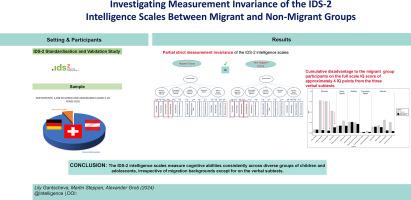Investigating measurement invariance of the IDS-2 intelligence scales between migrant and non-migrant groups
IF 2.8
2区 心理学
Q1 PSYCHOLOGY, MULTIDISCIPLINARY
引用次数: 0
Abstract
Intelligence plays a crucial role in various aspects of human life, impacting health, academic achievement, and socio-economic success. However, cultural and linguistic disparities in intelligence testing pose challenges, particularly for individuals from migrant backgrounds. This study replicates and extends the landmark study by Wicherts and Dolan (2010) exploring measurement invariance of the German language intelligence test, the Intelligence and Development Scales – 2 (IDS-2), between children and adolescents from migrant (N = 132) and non-migrant (N = 1898) groups. The results revealed partial strict measurement invariance in the IDS-2 intelligence scale subtests across the examined groups. The breach of full strict measurement invariance is primarily due to intercept differences on the verbally loaded subtests—Naming Categories, Naming Opposites, and Story Recall—highlighting the confounding impact of language complexity on test outcomes. These discrepancies resulted in a cumulative intercept difference disadvantaging migrant participants of approximately 4 IQ points on the Full-Scale IQ Score. The findings indicate that while the IDS-2 scales generally assess intelligence consistently across diverse groups, the influence of language complexity on the verbal subtests may result in a disadvantage for children and adolescents with migration backgrounds. To address these biases, we propose the development of non-verbal and culturally fair intelligence tests.

研究 IDS-2 智力测验量表在移民群体和非移民群体之间的测量不变性
智力在人类生活的各个方面都起着至关重要的作用,影响着健康、学业成绩和社会经济成就。然而,智力测试中的文化和语言差异带来了挑战,尤其是对来自移民背景的个人而言。本研究复制并扩展了 Wicherts 和 Dolan(2010 年)的一项里程碑式的研究,该研究探讨了德语智力测验--《智力与发展量表-2》(IDS-2)--在移民群体(132 人)和非移民群体(1898 人)的儿童和青少年之间的测量不变性。研究结果表明,IDS-2 智力量表各分测验在受试群体间存在部分严格测量不变性。违反完全严格测量不变量的主要原因是语言负荷分测验--命名类别、命名对立面和故事回忆--的截距差异,凸显了语言复杂性对测验结果的混杂影响。这些差异导致移民参与者在智商满分上的累计截距差异约为 4 个智商点。研究结果表明,虽然IDS-2量表对不同群体的智力评估总体上是一致的,但语言复杂性对言语分测验的影响可能会导致有移民背景的儿童和青少年处于不利地位。为了解决这些偏差,我们建议开发非语言和文化公平的智力测验。
本文章由计算机程序翻译,如有差异,请以英文原文为准。
求助全文
约1分钟内获得全文
求助全文
来源期刊

Intelligence
PSYCHOLOGY, MULTIDISCIPLINARY-
CiteScore
5.80
自引率
13.30%
发文量
64
审稿时长
69 days
期刊介绍:
This unique journal in psychology is devoted to publishing original research and theoretical studies and review papers that substantially contribute to the understanding of intelligence. It provides a new source of significant papers in psychometrics, tests and measurement, and all other empirical and theoretical studies in intelligence and mental retardation.
 求助内容:
求助内容: 应助结果提醒方式:
应助结果提醒方式:


